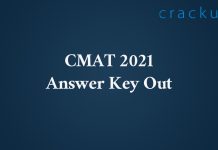CMAT Percentage Questions [Download PDF]
Download Percentage Questions for CMAT PDF – CMAT Percentage questions PDF by Cracku. Practice CMAT solved Percentage Questions paper tests, and these are the practice question to have a firm grasp on the Percentage topic in the XAT exam. Top 20 very Important Percentage Questions for XAT based on asked questions in previous exam papers. Click on the link below to download the Percentage Questions for CMAT PDF with detailed solutions.
Download Percentage Questions for CMAT
Enroll to CMAT 2023 Crash Course
Question 1: The monthly salary of a person was ₹50,000. He used to spend on three heads- personal and family expenses (E), taxes (T), philanthropy (P), and rest were his savings. E was 50% of the income, T was 20% of E and P was 15% of T. When his salary got raised by 40%, he maintained the percentage level of E, but T became 30% of E and P became 20% of T. By whatpercentage is the new savings more or less than the earlier savings? (correct up to one decimal place)
a) 16.4% more
b) 8.2% more
c) 16.4% less
d) 8.2% less
1) Answer (A)
Solution:
Initial salary of person = Rs. 50,000
Total % expenditure = $50+(\frac{20}{100}\times50)+(\frac{15}{100}\times\frac{20}{100}\times50)$
= $50+10+1.5=61.5\%$
=> % savings initially = $100-61.5=38.5\%$
Total savings = $\frac{38.5}{100}\times50,000=Rs.$ $19,250$
Now, new salary = Rs. 70,000
Similarly, total % expenditure = $50+(\frac{30}{100}\times50)+(\frac{20}{100}\times\frac{30}{100}\times50)$
= $50+15+3=68\%$
=> % savings initially = $100-68=32\%$
Total savings = $\frac{32}{100}\times70,000=Rs.$ $22,400$
$\therefore$ New savings are more by = $\frac{22400-19250}{19250}\times100\approx16.4\%$
=> Ans – (A)
Question 2: The average run rate of a cricket team during the first 20 overs is 4.5. What should be the askingrate per over for the next 30 overs,if it has to chase a target of 282 runs in total ?
a) 6.8
b) 6.3
c) 6.4
d) 6.0
2) Answer (C)
Solution:
Runs scored in the first 20 overs = $4.5\times20=90$
Runs required in the next 30 overs = $282-90=192$
=> Asking rate = $\frac{192}{30}=6.4$
=> Ans – (C)
Question 3: If the word PHOTOGRAPH is spelt with ‘F’ in place of ‘PH’, then what would bethe percentage reduction in the number of letters?
a) 25%
b) 10%
c) 20%
d) 18%
3) Answer (C)
Solution:
Number of letters in PHOTOGRAPH = 10
Number of letters in FOTOGRAF = 8
=> % reduction = $\frac{10-8}{10}\times100=20\%$
=> Ans – (C)
Question 4: While tabulation of marks scored in an examination by the students of a class, by mistake the marks scored by one student got recorded as 93 in place of 63, and thereby the average marks increased by 0.5. What was the number of students in the class?
a) 20
b) 30
c) 15
d) 60
4) Answer (D)
Solution:
Let number of students be $x$ and correct average marks be $y$
=> Total correct marks = $xy$
According to ques,
=> $\frac{xy+93-63}{x}=y+0.5$
=> $xy+30=xy+0.5x$
=> $x=\frac{30}{0.5}=60$
=> Ans – (D)
Question 5: The average of 18 numbers is 37.5. If six numbers of average X are added to them, then the average of all the numbers increases by one, The value of x is:
a) 40
b) 41.5
c) 42
d) 38.5
5) Answer (B)
Solution:
Sum of the 18 numbers = 37.5 $\times 18 = 675
($\because$ average = $\frac{sum of total terms}{number of terms}$)
Sum of the 6 numbers = 6 $\times$ X = 6X
Average of all the numbers = 37.5 + 1 = 38.5
$\frac{675 + 6X}{24}$ = 38.5$
675 + 6X = 24 $\times$ 38.5
6X = 924 – 675 = 249
X = 41.5
Question 6: In an examination, A obtained 10% more marks than B, B obtained 20% more marks than C and C obtained 32% less marks than D. If A obtained 272 more marks than C, then the marks obtained by B is:
a) 850
b) 816
c) 1020
d) 952
6) Answer (C)
Solution:
let the D obtained 100% marks.
Marks of C =
Marks of C = 100% $\times \frac{68}{100}$ = 68%
Marks of B = 68% $\times \frac{120}{100} $= 81.6%
Marks of A = 81.6% $\times \frac{110}{100}$ = 89.76%
Difference of the marks of A and C = 272
89.76% – 68% = 272
21.76% = 272
81.6% = $\frac{272}{21.76} \times 81.6$ = 1020
Marks obtained by B = 1020
Question 7: If 25% of half of x is equal to 2.5 times the value of 30% of one-fourth of y. then x is what percent more or less than y?
a) $33\frac{1}{3}\%$ more
b) 50% more
c) $33\frac{1}{3}\%$ less
d) 50% less
7) Answer (B)
Solution:
According to question,
x $\times \frac{1}{2} \times \frac{25}{100} = y \times 2.5 \times \frac{1}{4} \times \frac{30}{100}$
$\Rightarrow \frac{x}{8} = \frac{3y}{40} \times 2.5$
x = $\frac{3y}{2}$
x = $\frac{3y}{2} \times 100$ = 150% of y
x is 50% more than y.
Question 8: A, B and C spend 80%, 85% and 75% of their incomes, respectively. If their savings are in the ratio 8 : 9 : 20 and the difference between the incomes of A and C is ₹18,000, then the income of B is:
a) ₹24,000
b) ₹27,000
c) ₹30,000
d) ₹36,000
8) Answer (B)
Solution:
Let the Salary of A, B and C be a, b and c respectively.
Saving of A =$ a \times \frac{20}{100}$
Saving of B = $b \times \frac{15}{100}$
Saving of C = $c \times \frac{25}{100}$
According to the question,
$a \times \frac{20}{100} : b \times \frac{15}{100} : c \times \frac{25}{100} = 8 : 9 : 20$
$a \times \frac{1}{5} : b \times \frac{3}{20} : c \times \frac{1}{4} = 8 : 9 : 20$
a : b : c = 8 $\times 5 : 9 \times \frac{20}{3} : 20 \times 4$
a : b : c = 40 : 60 : 80 = 2 : 3 : 4
let the income of A, B and C be 2x, 3x and 4x.
Difference between the incomes of A and C = Rs.18,000
2x = 18000
x = 9000
Income of B = 3$\times 9000$ = Rs.27000
Question 9: Basir’s working hours per day were increased by 15% and his wages per hour were increased by 20%. By how much per cent did his daily earings increase?
a) 40
b) 38
c) 35
d) 36
9) Answer (B)
Solution:
Increment in working hour = 15%
Increment in wages = 20%
Let the working hours before the increment be 10 hours and daily wages per hour be Rs.10.
Daily wages of Basir = 10 $\times$ 10 = 100
working hours after increment = 10 $\times \frac{115}{100}$ = 11.5
Daily wages per hours after increment = 10 $\times \frac{120}{100}$ = 12
Daily wages of Basir after increment = 11.5 $\times$ 12 = 138
Increment in his daily earning = 138 – 100 = 38
Percentage increment in his daily earning = $\frac{38}{100} \times 100$ = 38%
Question 10: The average age of 120 students in a group is 13.56 years. 35% of the number of students are girls and the rest are boys. If the ratio of the average age of boys and girls is 6 : 5, then what is the average age (in years)of the girls?
a) 12
b) 11.6
c) 10
d) 14.4
10) Answer (A)
Solution:
Total students = 120
Number of girls = 120$ \times \frac{35}{100}$ = 42
Number of boys = 120 – 42 = 78
Total age of 120 student = 13.56$\times 120$ = 1627.2
Let the average age of boys and girls be 6x and 5x.
Total age of all girls = 42 $\times$ 5x = 210x
Total age of all boys = 78 $\times$ 6x = 468x
Total age of 120 student = total age of all girls + total age of all boys
1627.2 = 210x + 468x
x = 2.4
Average age of girls = 5x = 5$\times$ 2.4 = 12
Question 11: Monika spends 72% of her income. If her income increases by 20% and savings increase by 15%, then her expenditure increases by: (correct to 1 decimal place)
a) 20.8%
b) 20.2%
c) 21.9%
d) 19.8%
11) Answer (C)
Solution:
Let the income be Rs.100.
Expenditure = 72
Saving = 100 – 72 = 28
Income after increment = 120
Saving = 28 $\times \frac{115}{100}$ = Rs.32.2
Expenditure = 120 – 32.2 = 87.8
Increment = 87.8 – 72 = 15.8
Percentage expenditure Increment = $\frac{15.8}{72} \times 100 $= 21.9%
Question 12: If the price of petrol increases by 19%, and Sunitha intends to spend only an additional 12% on petrol, by what percent should she reduce the quantity of petrol purchased (nearest to an integer)?
a) 7
b) 6
c) 5
d) 8
12) Answer (B)
Solution:
Let the price of petrol be Rs.100 and Sunitha spent Rs.100.
After increment price of petrol = 119
Expenditure of petrol = 112
Reduce quantity of petrol = $\frac{119 – 112}{119} \times 100 = \frac{7}{119} \times 100$ = 5.88 ~ 6%
Question 13: The average of 33 numbers is 74. The average of the first 17 numbers is 72.8 and that of the last 17 numbers is 77.2. If the $17^{th}$ number is excluded, then what will be the average of the remaining numbers (correct to one decimal place)?
a) 72.9
b) 73.4
c) 71.6
d) 70.8
13) Answer (A)
Solution:
Average = sum of the terms/number of terms
Sum of the 33 numbers = 74 $\times$ 33 = 2442
The average of the first 17 numbers = 72.8
Sum of the first 17 numbers = 72.8 $\times$ 17 = 1237.6
The average of the last 17 numbers = 77.2
Sum of the first 17 numbers = 77.2 $\times$ 17 = 1312.4
$17^{th}$ number = sum of the first 17 numbers + sum of the last 17 numbers – sum of the 33 numbers= 1237.6 + 1312.4 -2442 = 108
Sum of the 32 numbers without $17^{th}$ number = 2442 – 108 = 2334
Average of 32 numbers = 2334/32 = 72.93
Question 14: 40 litres of 60% concentration of acid solution is added to 35 litres of 80% concentration of acid solution. What is the concentration of acid in the new solution?
a) $66\%$
b) $66\frac{2}{3}\%$
c) $69\frac{1}{3}\%$
d) $69\%$
14) Answer (C)
Solution:
Acid in 40 litres mixture = 40 $\times \frac{60}{100}$ = 24 litres
Water in 40 litres mixture = 40 – 24 = 16 litres
Acid in 35 litres mixture = 35 $\times \frac{80}{100}$ = 28 litres
Water in 35 litres mixture = 35 – 28 = 7 litres
Total acid in the new solution = 24 + 28 = 52
Total water in the new solution = 16 + 7 = 23
Concentration of acid in the new solution = $\frac{52}{52 + 23} \times 100 = \frac{52}{75} \times 100 = 69 \frac{1}{3}$%
Question 15: The average weight of a certain numberofstudents in a group is 72 kg. If 10 students having an average weight of 78 kg leave and 4 students having an average weightof 80 kg join the group, the average weight of the students in the group decreases by 0.7 kg, The number of students initially in the group is:
a) 56
b) 46
c) 44
d) 54
15) Answer (B)
Solution:
Let the total number of students be n.
Sum of the weight = 72n
Average weight of 10 students = 78 kg
Sum of the weight of 10 students = 78 $\times$ 100 = 780
Sum of the weight of 4 students = 80 $\times$ 4 = 320
ATQ,
Average = sum of the terms/number of the term
$\frac{72n – 780 + 320}{n – 10 + 4}$ = 72 – 0.7
72n – 460 = 71.3 $\times$ (n – 6)
72n – 460 = 71.3n – 427.8
0.7n = 32.2
n = 46
The number of students initially in the group is 46.
Question 16: A spends 65% of his income. His income is increased by 20.1% and his expenditure is increased by 25%. His savings:
a) Increase by 11%
b) Increase by 5%
c) Decrease by 5%
d) Decrease by 11%
16) Answer (A)
Solution:
Let the income be Rs.100.
Expendiiture = 65
Saving = 100 – 65 = 35
Income is increased by 20.1%..
So,
Income = Rs.120.1
Expenditure is increased by 25%..
So,
Expenditure = 65 $\times \frac{125}{100}$ = 81.25
Saving = 120.1 – 81.25 = Rs.38.85
Increment in saving = 38.85 35 = 3.85
Percentage increment in saving = $\frac{3.85}{35} \times 100$ = 11%
Question 17: The average weight of a certain numberofstudents in a group is 72 kg. If 10 students having an average weight of 78 kg leave and 4 students having an average weightof 80 kg join the group, the average weight of the students in the group decreases by 0.7 kg, The number of students initially in the group is:
a) 56
b) 46
c) 44
d) 54
17) Answer (B)
Solution:
Let the total number of students be n.
Sum of the weight = 72n
Average weight of 10 students = 78 kg
Sum of the weight of 10 students = 78 $\times$ 100 = 780
Sum of the weight of 4 students = 80 $\times$ 4 = 320
ATQ,
Average = sum of the terms/number of the term
$\frac{72n – 780 + 320}{n – 10 + 4}$ = 72 – 0.7
72n – 460 = 71.3 $\times$ (n – 6)
72n – 460 = 71.3n – 427.8
0.7n = 32.2
n = 46
The number of students initially in the group is 46.
Question 18: 40 litres of 60% concentration of acid solution is added to 35 litres of 80% concentration of acid solution. What is the concentration of acid in the new solution?
a) $66\%$
b) $66\frac{2}{3}\%$
c) $69\frac{1}{3}\%$
d) $69\%$
18) Answer (C)
Solution:
Acid in 40 litres mixture = 40 $\times \frac{60}{100}$ = 24 litres
Water in 40 litres mixture = 40 – 24 = 16 litres
Acid in 35 litres mixture = 35 $\times \frac{80}{100}$ = 28 litres
Water in 35 litres mixture = 35 – 28 = 7 litres
Total acid in the new solution = 24 + 28 = 52
Total water in the new solution = 16 + 7 = 23
Concentration of acid in the new solution = $\frac{52}{52 + 23} \times 100 = \frac{52}{75} \times 100 = 69 \frac{1}{3}$%
Question 19: The average of 33 numbers is 74. The average of the first 17 numbers is 72.8 and that of the last 17 numbers is 77.2. If the $17^{th}$ number is excluded, then what will be the average of the remaining numbers (correct to one decimal place)?
a) 72.9
b) 73.4
c) 71.6
d) 70.8
19) Answer (A)
Solution:
Average = sum of the terms/number of terms
Sum of the 33 numbers = 74 $\times$ 33 = 2442
The average of the first 17 numbers = 72.8
Sum of the first 17 numbers = 72.8 $\times$ 17 = 1237.6
The average of the last 17 numbers = 77.2
Sum of the first 17 numbers = 77.2 $\times$ 17 = 1312.4
$17^{th}$ number = sum of the first 17 numbers + sum of the last 17 numbers – sum of the 33 numbers= 1237.6 + 1312.4 -2442 = 108
Sum of the 32 numbers without $17^{th}$ number = 2442 – 108 = 2334
Average of 32 numbers = 2334/32 = 72.93
Question 20: If the price of petrol increases by 19%, and Sunitha intends to spend only an additional 12% on petrol, by what percent should she reduce the quantity of petrol purchased (nearest to an integer)?
a) 7
b) 6
c) 5
d) 8
20) Answer (B)
Solution:
Let the price of petrol be Rs.100 and Sunitha spent Rs.100.
After increment price of petrol = 119
Expenditure of petrol = 112
Reduce quantity of petrol = $\frac{119 – 112}{119} \times 100 = \frac{7}{119} \times 100$ = 5.88 ~ 6%





